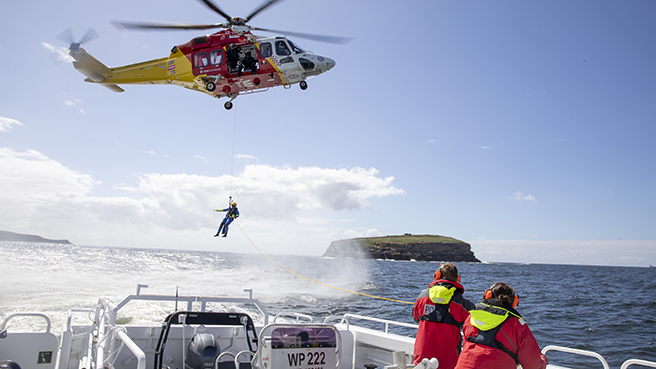
Dangling a fishing line off Norah Head on the NSW Central Coast sounds like a relaxing pastime.
Dangling on the winch from the Westpac Rescue Helicopter off Norah Head with the other end of the line attached to a Water Police launch – well, it doesn’t get much more intense.
That’s the scenario captured in the dramatic photo above, and Critical Care Helicopter Paramedic Adam Butt is the person suspended in mid-air.
In this case, Adam and the team are practicing hi-line rescue techniques as part of a multiagency exercise.
Hi-line rescues are the most complex kind of rescue over water for helicopter paramedics.
“There’s an incredible amount of teamwork involved and all members of the team need to be aware of what their role is in completing the exercise
successfully,” explained Adam.
“It’s very intense training, which is designed to be just as complex as any situation you’d face operationally.”
A hi-line is a line with a weight on its end, attached by a weak link to the helicopter’s winch cable.
“The aim is to land the weighted line on the vessel, which assists the crew to winch the Critical Care Helicopter Paramedic onto the vessel. It is then used to assist with patient extraction via an accompanied Air-Lift Rescue Vest (ARV), rescue strop or stretcher winch,” said Adam.
Keeping hi-line technique currency is an annual requirement for all aeromedical paramedics.
NSW Ambulance Aeromedical Operations is preparing for a busy Summer.
With the easing of COVID-19 restrictions, first responders in the Hunter/Central Coast region are bracing for more people to head back into the ocean
this year than in recent years.
Aeromedical staff covering the Hunter region recently met with Council lifeguards in Newcastle to discuss protocols in preparation for the coming summer.
“Safe and successful rescue missions start months before the holiday season,” said Adam Butt.
“They start with preparation, training exercises and by building strong collaborative relationships among local rescue agencies.
“This experience is what you draw on when lives are on the line.”
